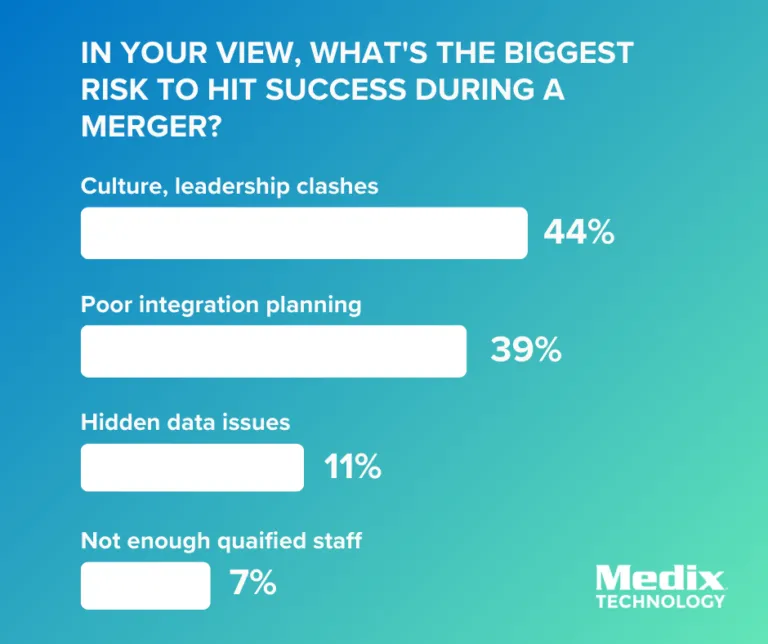Merging Technology Is Easy. Merging Cultures Is Hard: Healthcare M&A Cultural Challenges

When healthcare organizations go through mergers and acquisitions, the technology work usually gets the first and loudest attention. Systems need to connect. Platforms must align. Data has to move from one environment to another — all while keeping patient care running smoothly.
For healthcare IT leaders, this is high-stakes work. But it’s also familiar. Whether it’s consolidating electronic health records (EHRs), unifying patient portals, or integrating revenue cycle systems, technical challenges have frameworks, timelines, and proven solutions. If something goes wrong, there’s usually a documented way to fix it.
Culture is a different story — and it’s the source of some of the most complex healthcare M&A cultural challenges.
What’s the Biggest Risk in Healthcare IT Mergers and Acquisitions?
At Medix Technology, we asked healthcare IT professionals what they see as the biggest risk to IT success during a merger. In our LinkedIn poll, nearly half of respondents — 44% — said culture and leadership clashes were the top concern. By comparison, 39% cited poor integration planning, 11% pointed to hidden data issues, and just 7% chose lack of qualified staff.
These results align with decades of M&A research: Between 70% and 90% of mergers fail to meet their intended goals, and cultural challenges consistently rank among the top reasons why.
In other words, the success of a healthcare IT merger isn’t determined solely by how well the systems connect — it’s about how well the people work together once they do.
Why Does Technology Integration Feel More Predictable Than Culture?
There’s a reason the technical side of healthcare IT mergers and acquisitions dominates early planning: It’s easier to control.
IT integration can be scoped, budgeted, and tracked. Leaders can measure milestones in terms of migrated data, decommissioned applications, and completed tests. There’s a tangible “go-live” date that signals success.
Even when things go off track, experienced IT teams can draw on established playbooks: escalating to a vendor, running new scripts, adjusting configurations. Problems are visible and solvable within a known framework.
That level of predictability is comforting in the uncertainty of a merger.
Why Is Cultural Integration So Much Harder?
Culture, however, resists straightforward project management. It’s the sum of decision-making styles, communication habits, priorities, and values — most of which are unwritten and deeply ingrained.
When two healthcare organizations merge, these differences often emerge in subtle but disruptive ways. One team’s efficient process may feel rushed to another. Leadership behaviors that inspire one group may alienate another.
And because healthcare IT is tightly connected to clinical operations, those cultural differences can quickly spill over into patient care. A new interface may work perfectly on a technical level but cause frustration if it disrupts a nurse’s workflow. That frustration can snowball into resistance, slowed adoption, and ultimately, underperformance of the merged systems.
What Are the Real Costs of Cultural Misalignment in M&A?
Cultural misalignment isn’t just a “soft” challenge — it has tangible operational and financial consequences in healthcare IT mergers and acquisitions:
- Slower adoption of new tools and workflows, reducing ROI.
- Higher turnover, especially among critical IT or clinical staff.
- Weakened collaboration across formerly separate teams.
- Decreased morale, leading to disengagement and missed performance targets.
In healthcare, where every system decision touches patient care, these effects can translate into reduced service quality, compliance risks, and reputational damage.
How Can Leaders Integrate People with the Same Rigor as Technology?
The irony is that cultural integration benefits from the same disciplined approach that works for technical integration — it’s just not applied as often.
When healthcare IT leaders give cultural alignment the same attention as system alignment, they can:
- Identify points of friction early.
- Develop unified communication strategies.
- Embed change champions across both organizations.
This intentional approach creates trust and accelerates adoption — two factors critical to realizing the full value of healthcare IT mergers and acquisitions.
How Can the Right Talent Partner Bridge the Gap Between Tech and Culture?
Successfully merging cultures while integrating technology requires the right people in the right roles. That’s where a specialized and strategic healthcare IT partner can be invaluable.
At Medix Technology, we’ve seen post-merger IT teams thrive when they have more than just technical experts. Success also depends on:
- Change management leaders who can communicate the “why” and guide teams through uncertainty.
- Cross-functional professionals who understand both IT and clinical operations.
- Cultural translators who can align workflows, leadership styles, and values across merging organizations.
Our approach ensures healthcare organizations have the solutions to make both the systems and the people work together — because in M&A, one without the other is a recipe for missed opportunities.
Are You Giving Culture the Same Attention as Technology in Your M&A?
As you plan your merger or acquisition, ask yourself: Are we giving cultural integration the same resources, planning, and leadership attention as technology integration?
If not, you might be solving the visible problems while leaving the hidden risks unchecked.
Merging technology is challenging. Merging cultures is harder. But when both are addressed with equal care, healthcare organizations can emerge from M&A not just with connected systems, but with united teams ready to deliver better care together.
Key Takeaways
- Cultural misalignment is the top risk in healthcare IT M&A, according to 44% of leaders in a Medix Technology poll.
- Technical integration can be planned and predicted; cultural integration is harder to control.
- Ignoring healthcare M&A cultural challenges can lead to slower adoption, higher turnover, and unrealized merger value.
- Addressing culture early — with the right talent and change management — can secure both tech and people success.
If you’re preparing for a healthcare IT merger, Medix Technology can help ensure both your systems and your teams integrate successfully. From EHR analysts to governance and change management, we provide the solutions to make post-merger success possible. Contact us to get started.






